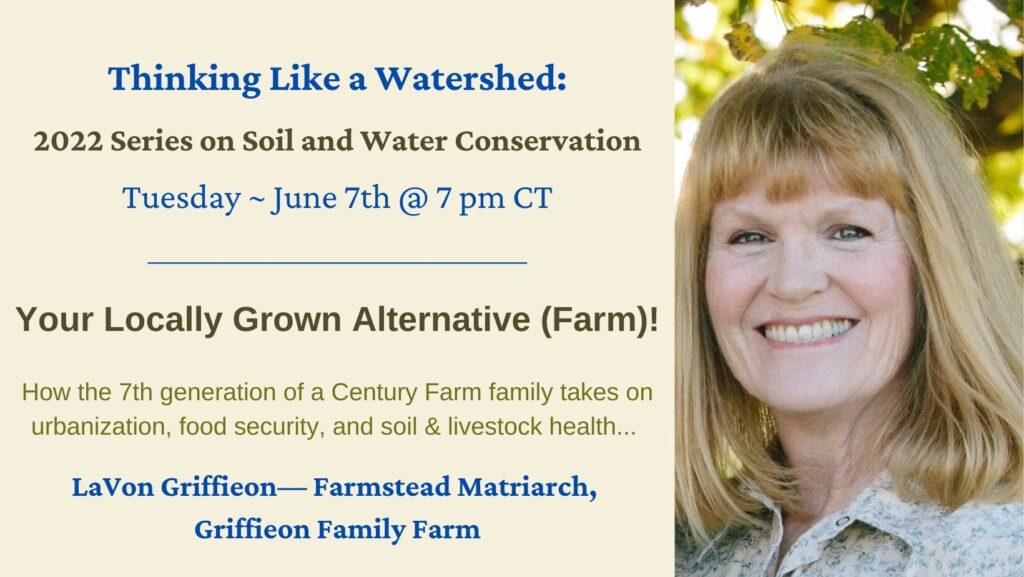
Sampling on woodland edges in deer season makes orange everything an imperative. To see this new site’s data from this fall, click here! To see past results just downstream, click here! Photo by Caroline van Schaik
“Match” farmer survey ready!
The goals of the “Match Made in Heaven” project are straightforward if ambitious. Simply put but hard to grasp, the 6-state working group (UMRI is a member) wants to forge more marriages between crop and livestock producers in a way that, at the end of every day, finds more soil covered more months of the year. This foundational bottom line positively affects farm financials, every aspect of the environment including drinking water and human health, climate mitigation, and communities. The project is led by Green Lands Blue Waters Midwest Perennial Forage Working Group. A survey, designed to tease out the nuances that keep the reintegration of livestock into crop operations from occurring, is just about ready. If you as a farmer wants to take it or your organization wants to help distribute it, please contact Caroline van Schaik. There is some financial help for related costs. We want 10,000 responses so every effort at outreach is deeply appreciated.
The entire project can be understood at Green Lands Blue Waters Midwest Perennial Forage Working Group or in past months on these pages. Please contact Caroline van Schaik with questions.
Cedar River re-do
The Cedar River has plenty to commend it but water quality is not high on the list. Still, there is a step forward in Austin, MN even as drainage issues threaten two steps back.
The step forward was nurtured and continues to be monitored by the local chapter of the Izaak Walton League. It comes in the form of modest changes that tighten up Mower County’s septic system ordinance. One outcome is that more systems are being evaluated and upgrades/compliance is up from previous years, sometimes on a previously unheard of voluntary basis. These changes came about in part on the back of a summer of sampling by 40 volunteers whose E. coli testing and subsequent DNA analyses uncovered human feces in the Cedar River and many of its tributaries. Cow and pig manure were found in almost all samples as well. A treatment plant upgrade, a survey of a troublesome 75-home development and emergency holding tanks (half are out of compliance), some cost-share funds to help with inspections – and late in November, an inquiry for the Austin team to present its sampling protocol and data – add up to movement, maybe even more than a single step’s worth.
The brewing drainage issue at the mouth of the Cedar River has prompted an interest in returning to the table set in January 2020 to update Cedar enthusiasts on the Minnesota and Iowa sides of the watershed. There is more in play these three years later – what’s the status, who’s doing what, and what is needed sooner than later to redirect the health of the river? This ecosystem look at a river that knows no political boundaries will take place in late winter. Please contact Caroline van Schaik or Christine Curry to participate.

Stream team volunteers decided that a spring encounter with a touchy landowner was one time too many and this fall, moved upstream on the same creek. Pine Creek in Minnesota’s Driftless region is a favorite destination for anglers, and water quality bears this out despite poor livestock management and crops that erode soil and chemicals perilously close. Still, there are good riparian buffers to filter out residue of all manner and volunteers’ data produce a steady stream of good news.
Fish and …Sheep
The synergy between fish to fry and grass to graze was the underlying theme of a presentation made in late November to the Win-Cres chapter of Trout Unlimited in Winona. UMRI staffer, Caroline van Schaik, herself a sheep grazier, took a Save Our Streams (SOS) kit and walked anglers through the protocols for volunteer stream monitoring. Upland management – the corn fields our streams meander through, livestock, manure spills, cover crops versus bare soil – impact water quality, she said, so looking up from fishing to pay attention to the riparian corridors is as essential as rods and flies.
Driftless stream teams finished their last site on Nov. 26 – creating somewhat of a new site in the process to avoid a cranky landowner. One of the premises of SOS sampling is that while the water is public, access must be legally procured. We were met with open arms and a new volunteer by picking a driveway just upstream from the initial site.
While we have exactly one prerequisite for joining a Driftless stream team – enthusiasm! – please note that in-person training is back and we are hosting one next spring. If this interests you, please contact Caroline van Schaik to be put on our list for follow up. Space will be limited so that stream side can mean exactly that for everyone. Thanks in advance to the Winona Will Dilg chapter and the national Endowment Board of the Izaak Walton League for helping with workshop funds.
The SOS program, begun 51 years ago, is a national effort by the Izaak Walton League to engage all sorts of people in collecting data across the US according to standard protocols. Data are uploaded to a searchable hub and are used at the federal level to inform water policy and practice. In-person training had been suspended due to Covid. For more on the SOS program and what parts of the training are already online, click here. By the way, anyone can browse the Clean Water Hub database to see what other streams look like all over the United States.

Save Our Streams (SOS) volunteers take on all sorts of weather, including rain tempered by setting up under a bridge, as here on Mill Creek in Chatfield, MN. The creek is showing some decline according to stream team data – fewer macro invertebrates, a little more nitrates, and less dissolved oxygen when compared to similar dates. We are watchful. Several sites this fall registered warmer water than a year ago: Mill Creek was about 15 degrees F warmer, for example. Photo by Caroline van Schaik
UMRI’s “Thinking Like a Watershed” series has gone fishin’!
Not wishing to compete with long summer days – and who would want to! – we hosted our final 2022 “Thinking Like a Watershed” episode on June 7. Go outside! We will see you in January for stories to inspire a winter’s night, as told by ourselves and good partners on this road to a better landscape. The linked recording of the June 7 presentation – by the head of a 7th generation farm creatively grappling with urban sprawl – is below, as are links to all past programs. Take a listen, take some hope, and let us know if you would like us to consider a certain someone or topic in programs to come. And if you are new to the series, we use these words to describe what shapes it: This monthly series is a project of the Upper Mississippi River Initiative (UMRI) of the Izaak Walton League of America, with co-hosts Chris Henning of the Panora Conservation Chapter and Des Moines Chapter Communication Director, Bud Hartley. We feature guests for 30-40 minute presentations that shed daylight on good works done in the name of the Mississippi and its uplands. In this way we uplift our shared goals for a cleaner river, a cared for environment, and kinder communities. Recorded programs are available shortly after they air live.
Links to recent “Thinking” presentations
— “Your Locally Grown Alternative (Farm)”: Thinking Like a Watershed ~ LaVon Griffieon- Tuesday June 7, 2022 How the 7th generation of a Century Farm family takes on urbanization, food security, and soil and livestock health… with farmstead matriarch, LaVon Griffieon
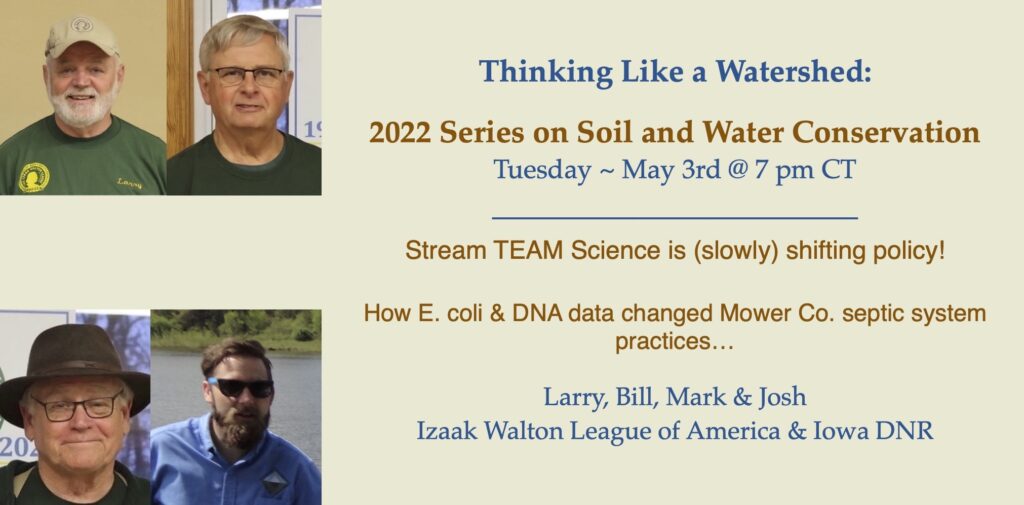
— “Stream TEAM Science is (slowly) shifting policy!” Thinking Like a Watershed ~ Tuesday, May 3, 2022
How E. coli & DNA data changed Mower Co. septic system practices…
A discussion with leaders Larry Dolphin, Bill Buckley, Mark Owens, lifelong members of the Izaak Walton League (IWLA), and Josh Balk, Iowa Department of Natural Resources (DNR)
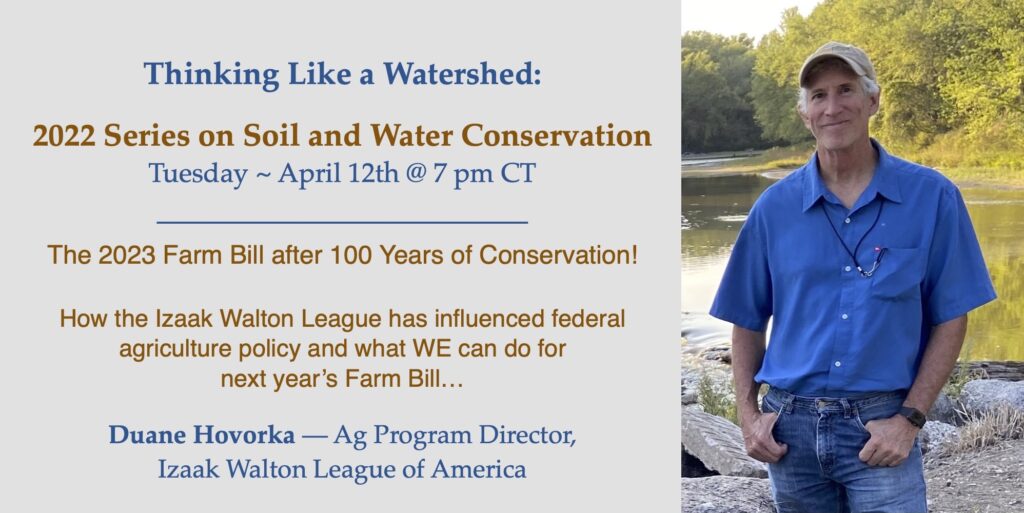
—“The 2023 Farm Bill after 100 Years of Conservation!” Thinking Like a Watershed ~ Duane Hovorka- April 12th, 2022
How the Izaak Walton League has influenced federal agriculture policy and what WE can do for next year’s Farm Bill…with Duane Hovorka, Agriculture Program Director, Izaak Walton League of America
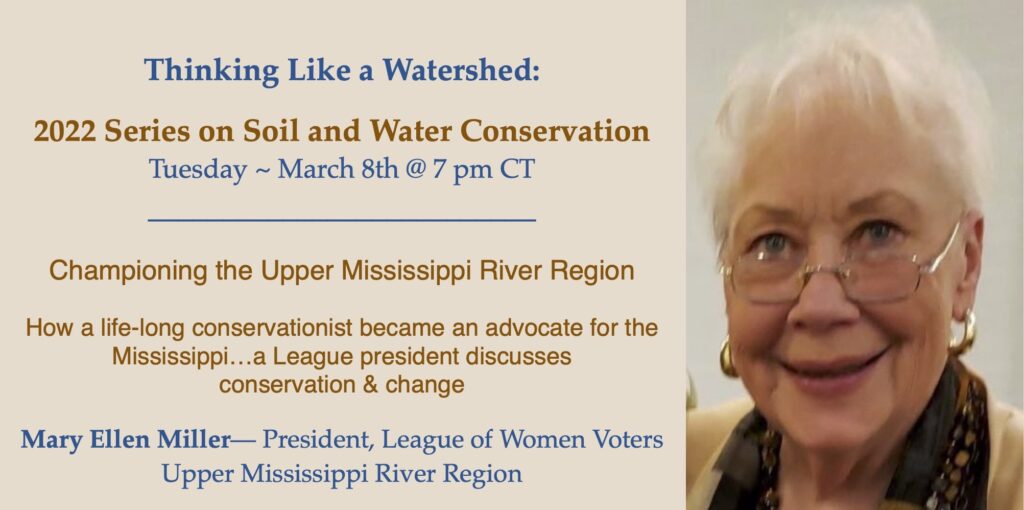
— “Championing the Upper Mississippi River Region” Thinking Like a Watershed ~ Mary Ellen Miller— March 8th, 2022
How a life-long conservationist became an advocate for the Mississippi…a League president discusses conservation & change with Mary Ellen Miller, President, League of Women Voters Upper Mississippi River Region
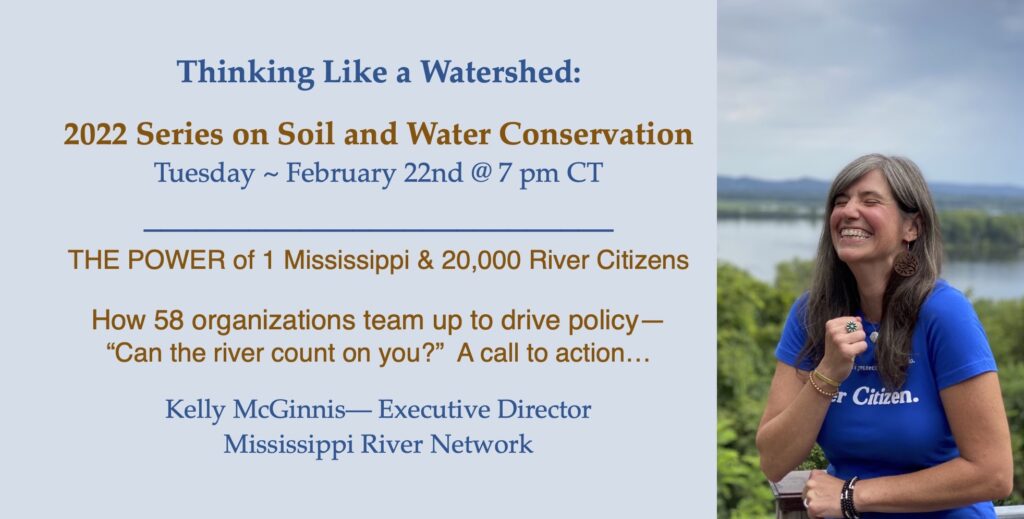
—“The POWER of 1 Mississippi & 20,000 River Citizens” Thinking Like a Watershed ~ Kelly McGinnis— February 22nd, 2022 How 58 organizations team up to drive policy—“Can the river count on you?” A call to action…
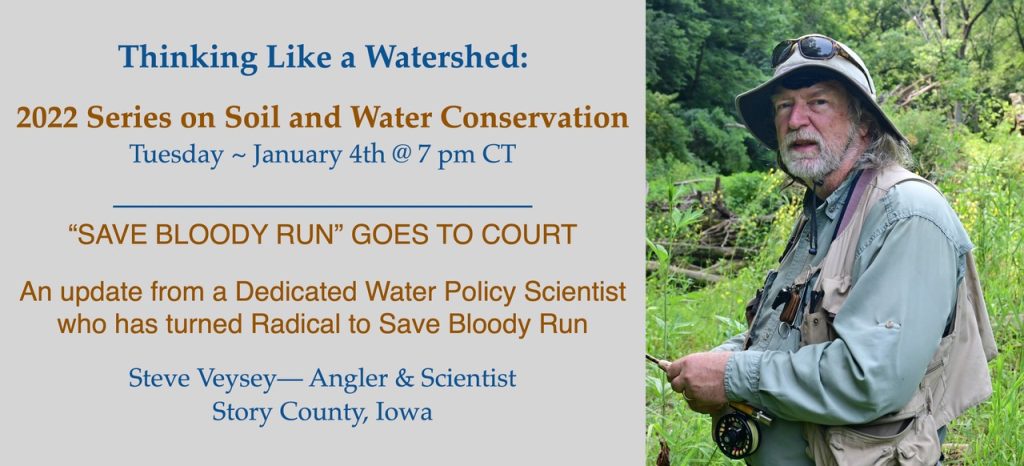
Photo by: David Thoreson
— “Save Bloody Run Goes to Court” Thinking Like a Watershed ~ Steve Veysey— January 4th, 2022 An update from a Dedicated Water Policy Scientist who has turned Radical to Save Bloody Run.
—“Heartland Heroines” Thinking Like a Watershed ~ Robin Moore & Denise O’Brien— June 1, 2021 How two savvy conservationists empower working farm landowners to put their inner land ethic to work.
—“Planting Seeds to Grow Vibrant Communities” Thinking Like a Watershed ~ Chris Deal & Art Cullen— May 4, 2021 How Jefferson, Iowa’s Chris Deal is working with California Rep. Ro Khanna and others to grow vibrant rural communities in the Heartland with perspectives from Pulitzer Prize—winning journalist and editor of The Storm Lake Times, Art Cullen.
—“Watershed Bridges— Green to Blue” Thinking Like a Watershed ~ Vicki Nichols Goldstein & Seth Watkins— April 6, 2021 How improving soil health and water quality in Iowa and other inland states benefit watersheds that provide critical services from land to sea.
—“Local Heroes in Howard County” Thinking Like a Watershed ~ Neil Shaffer & Hunter Slifka— March 2, 2021 How they have incorporated several thousand acres of land under conservation programs–the largest percentage in Iowa.
—“The Accidental Conservationist” Thinking Like a Watershed ~ Wayne Fredericks— February 2, 2021 How an Iowa Farmer is Improving Natural Capital while Increasing Profits with Conservationist and Farmer, Wayne Fredericks from Mitchell County, Iowa.

